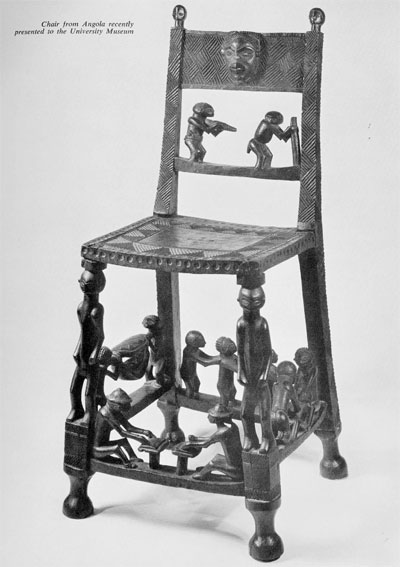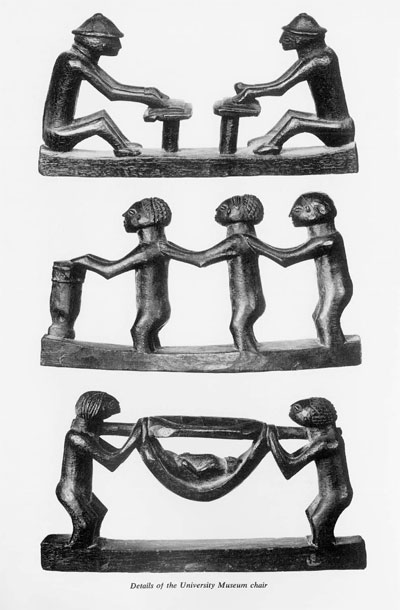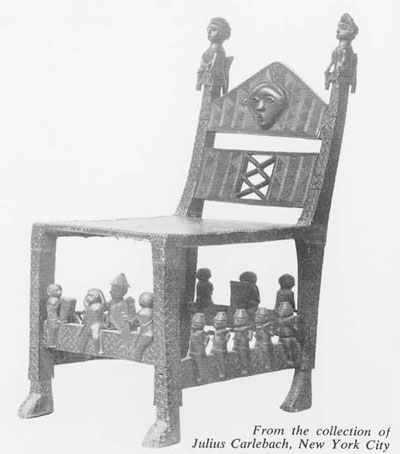
Museum Object Number: 62-3-1

Only in recent times has the chair become a household necessity. From antiquity the chair was reserved for persons of authority and occasions of great dignity and state. A chief or emperor ruled from his seat of authority–or throne. In a like manner religious authority vested itself in a chair or cathedra. So bound up was authority with furniture that the symbol became the force as men ruled ex cathedra. This idea follows down through philology as in the seat of government or to take the chair as the chairman.
Chairs for everyday use began in the Renaissance and were usually made of wood with some upholstery. By the middle 17th century leather began as a seat covering and often was used on the backpiece as well. Pictured is a 17th century Portuguese chair of simple style–a straight side chair with carved splats–two opposite sides lower placed than the remaining two. Scroll designs often were cut out or overlaid in carving in these bracing members. Tooled leather served as seat and backpiece. Both were anchored down with large roundheaded tacks.
Of interest in the example in a private collection in Portugal is the heraldic crested tooling in the backpiece. The family crest added authority to the chair. Each sidepost terminates in a brass finial. A chair of this type might well have been taken to Portuguese Africa in the 17th century by a local governor for the district of Angola. It would have seemed only proper that the law be administered from a chair bearing perhaps the royal arms in the tooled leather back and seat. Undoubtedly the church, with its episcopal seat in Sao Paulo de Loanda from the early 17th century on, imported from the motherland proper chairs for her ecclesiastical needs.
Local Balunda and Bajok chieftains and kings would have first come in contact with chairs in their relations with the official representatives of their Portuguese colonizers. For them the broad back of a crouching subject had more often sufficed as a seat, as did the stool often carved with caryatid figures representing the subjects.
The Museum has recently acquired a chair, the generous gift of Mrs. Webster Plass, from Angola. This chair, thirty-three inches high, is exactly the same style as the Portuguese prototype although it was carved for a Bajok chief by a native craftsman in the 19th century. The anonymous carver presents us with a side chair having four splats, four legs, a seat, and a back rest. As the model chair had finials at the top of the back, the Angola chair substitutes human heads. Chairs of this type have often been carved in Portuguese Africa as was the example in the collection of Julius Carlebach in New York City. Here the finials are even more baroque representing two dignitaries each in turn seated in a chair.

In some cases actual leather was used for the upholstery of the seat. A chair in the collection of Mr. and Mrs. Clark E. Stillman in New York City utilizes a tanned skin stretched over the solid wooden seat to better emulate the European model.

The Museum’s acquisition however employs a much more novel solution, carving directly into the wooden seat a simulation of patterned tooling and a regular series of convex cuts to copy the brass-headed upholstery tacks of the European tradition. As for the tooled leather back, the heraldic crest is replaced in the Bajok example by a wooden mask carved in high relief. The face mask, colored a lighter brown than the patinated wood of the rest of the chair, has the characteristic “spectacled” eyes and large-lipped mouth of the Bajok style. Both New York examples also substitute a mask for the European crest.
Native improvements on the basic Portuguese chair provide the charm and style of the museum piece; the local convention of using human figures as caryatids in the indigenous stools has been introduced in the forelegs; the splats become stages for “genre” tableaux.
The back slat discovers a native with a blunderbuss aiming at a quite docile, close range baboon. The side splats vary. In the front scene, two natives, complete with typical hats resembling helmets, play a game perhaps chess. Music supplies the theme of another in which three drummers in a rhythmic frieze attend a large standing drum. Perhaps they played for the circumcision ceremony being performed on a third rung. Two natives carry a litter in the fourth. The litter is an especially elaborate one having a canopy decorated with diamonds. Here is the only other place the light brown color is employed–in alternating diamonds.
Whether the Bajok carver borrows from his Congo neighbors or the European tradition, he brings to his creation unmistakable hallmarks of Bajokwe style.
Such is the chair.
